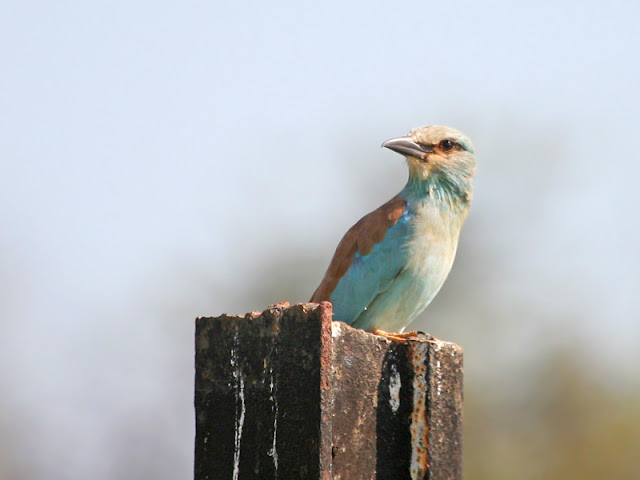We duly arrived at the start of the, roughly 25km, drive at 05h30 with the sky just beginning to lighten. It was a bit chilly so we stopped to get a cup of coffee out of the flask and immediately spotted a Marsh Owl hunting over the grasslands. As the light strengthened we set off along the dirt road for Kgomo-Kgomo. Burchells Coucals were out and about quite early and we spotted this one enjoying the first rays of the morning.
 |
| Burchells Coucal |
European Marsh Warblers were in abundance as were Willow Warblers, both of which we heard calling everytime we stopped to check other more visible birds. We tried on many occassions to get them come out for a photo shoot but they preferred to remain hidden in the dense bushes next to the road. Another common migrant on this road is the Red-backed Shrike which could be heard almost every 100m.
 |
| Sub-adult male Red-backed Shrike still showing some immature plumage on the breast! |
We found a European Roller along the road. These birds have spread all the way down to the Western Cape this year with several being seen in different locations around the South Western part of South Africa. We did not see any of the resident Lilac-breasted Rollers on the day.
 |
| European Roller |
At one stage we encountered a few Levaillants Cuckoos which we identified by call. They later flew over the road and one individual sat in the open for a quick snap!
 |
| Levaillants Cuckoo |
We also encountered a Village Indigobird calling from the top of a tree, these are quite common in this area and are found quite regularly.
 |
| Village Indigobird |
Many of the photos I took were from a distance as the birds are quite skittish and stay away from the edge of the road. My best bird for the day was definately the Orange-breasted Bush-shrike as I often hear them but views are not always optimal. This chap was very obliging and allowed good binocular views, again photographing them at close range is not always an option..at least you can get an idea of what he looked like! Handsome, isn't he! The call is similar to someone whistling for his dog!
 |
| Orange-breasted Bush-shrike |
Immature Southern Masked Weavers were busy trying out their nest building skills and even stealing material from each others nests. This guy still has some way to go before a female will accept his attempts!
 |
| Immature Southern Masked Weaver |
Another very vocal bird is the Magpie Shrike which has a musical whistled peeroo-peeroo call heard often along the road.
 |
| Magpie Shrike |
A pair of Cardinal Woodpeckers were busy excavating a nest hole and with a bit of persuasion we enticed the male out for qick pic.
 |
| Male Cardinal Woodpecker |
Three species of waxbill are often found in the area. Blue, Black-cheeked and Violet-eared Waxbill of which the Blue is the most common.
 |
| Blue Waxbill |
There are also three species of Whydah found here, Pin-tailed, Long-tailed Paradise and Shaft-tailed Whydah. We only managed to find two of the three as Shaft-tailed eluded us, they are most often found on Crake road but this seems to have been closed to the public.
 |
| Long-tailed Paradise Whydah |
Rufousnaped Larks are common along the grassy stretches of Zaagkuildrift rd and Sabota Larks prefer the woodlands. By the time we found this individual it had heated up and he looked decidedly hot and bothered.
 |
| Sabota Lark |
The heat also brought out the butterflies and I got a few new species for my photo database. The mud puddles along the road provided a gathering point for quite a few species including African Leopard, Brown-veined Whites, Zebra Whites, White-cloaked Skippers, Yellow and Blue Pansies, Small Elfins, Common Diadem and Broadbordered Grass Yellows.
 |
| From left to right Zebra White, 2x Brownveined Whites and White cloaked Skipper |
 |
| Small Elfin |
 |
| African Leopard |
Eventually we reached Kgomo-Kgomo with its wide floodplain after a 5hr drive. We were not disappointed as the floodplain near the bridge was full of waterbirds (no pics unfortunately). Interesting birds in the village were Red-headed Finch (which are common in my garden) and two Greater Kestrel hunting insects.
 |
| Red-headed Finch |
 |
| Greater Kestrel |
Other birds worth mentioning were Great Spotted Cuckoo, Black Stork, Painted Snipe and some birders reported a Striped Crake but we had no luck locating it....
All in all it was a very leisurely mornings birding and the food was good, I tried to officially designate Lorraine (Tommys other half) as our chief sandwich maker but she surprisingly declined?? Our tally for the day was 117 species in roughly 6 hours even though we missed some common birds found on the Kgomo-Kgomo floodplain that were conspicuous in their absence.

No comments:
Post a Comment